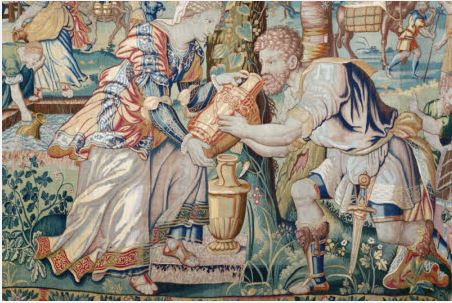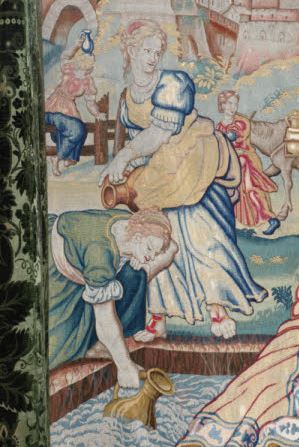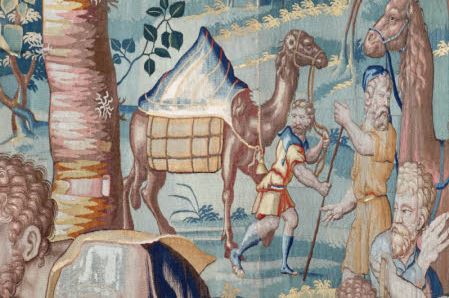This blog continues in the vein of the “Europe & the U.S. in 99 Objects” series. Descriptions were written by Dr. Gabriella de la Rosa at the National Trust has started this project for the National Trust, originally published here, by delving into the Trust’s collections – nearly 1 million objects held at over 200 historic properties across the United Kingdom – to find objects with interesting, unusual and unexpected connections to Europe. These objects and their stories are being published in the form of a digital diary on the National Trust Collections website. Since we are woefully behind Dr. de la Rosa’s 99 objects blog, and in a commitment to my art history education, I plan to highlight some objects that are also highlighted on the National Trust site for the ROF blog!
If there are any NT objects you see on your travels that you would like me to highlight, or that you would like to write about, you know I love to hear from members. agoldman@royal-oak.org or https://www.facebook.com/royaloakfoundation/
A few years ago I had the opportunity to the Manufacture des Gobelins Tapestry Museum in Paris, which was an eye opening experience of the immense work behind a tapestry. Perhaps this should have been obvious before, for starters the works are very large, this tapestry is 11.5 ft high and 15 ft wide. The story of Rebecca and Well summarized very succinctly is Isaac, the son of Abraham needed a wife, so Abraham sent his servant to find this wife. The servant wanted to make sure the woman was a good person, so he decided that if he asked her for water and she also offered water to his camels she was the one. This is often recounted as a story of giving, lauding Rebecca’s generosity.
Here is a detail of Eliezer, Abraham’s servant while Rebecca holds the pitcher.
‘Rebecca at the Well’ is the fourth tapestry in the ‘Story of Abraham’ set at Hardwick, and the tenth and final scene in the series as a whole.
The National Trust writes “The four ‘Story of Abraham’ tapestries are based on a series of designs first woven in Brussels in around 1540. The earliest known set was bought by Henry VIII in 1543-4 and survives at Hampton Court Palace, and further sets were woven in the sixteenth century for other patrons.
The tapestries at Hardwick belong to a second generation of ‘Abraham’ tapestries, woven in the late sixteenth century from modified copies of the original cartoons. The original ‘Abraham’ series comprised ten scenes illustrating the major events in Abraham’s life, and emphasizing his role as the progenitor of the Hebrew nation, his covenant with God and its continuation through his son Isaac. The ten subjects are ‘God Commands Abraham to Lead the Israelites into Canaan’, ‘The Return of Sarah by the Egyptians’, ‘The Parting of Abraham and Lot’, ‘The Meeting of Abraham and Melchisedek’, ‘God Appears to Abraham’, ‘The Circumcision of Isaac’, ‘The Sacrifice of Isaac’, ‘Abraham Purchases the Field of Ephron’, ‘The Oath and Departure of Eliezer’ and ‘Rebecca at the Well’.
Thomas Campbell (the former head of the Met) has argued that the ‘Abraham’ set woven for Henry VIII was the first set ever woven, and that Henry may have commissioned the designs himself. The subject of Abraham was part of a personal iconography which aligned Henry with Old Testament patriarchs as a means of justifying his new position as head of the Church of England. Abraham also figured in Christian typology as the progenitor of Christ, and would therefore have had additional resonance following the birth of Henry’s son Edward in 1537.
Henry’s ‘Abraham’ tapestries were among the richest in his collection and may well have been known to the Countess of Shrewsbury (‘Bess of Hardwick’) when she purchased her own version of the designs at the end of the sixteenth century. The designer of the ‘Abraham’ series is unknown. The series has been attributed to Bernard van Orley (c. 1488-1541), and more recently to either Michiel Coxcie (1499-1592) or Pieter Coecke van Aelst (1502-1550), both of whom designed large-scale narrative tapestries for the Brussels industry in the mid sixteenth century. Examining the available evidence Thomas Campbell has suggested that the designs were in fact a collaboration, with the initial idea being supplied by van Orley and the finished designs being completed after his death in 1541 by his pupil Pieter Coecke van Aelst (Campbell 2003, pp, 63-4).
The cartoons from which Henry VIII’s ‘Abraham’ tapestries were woven were re-used more than once in Brussels in the mid sixteenth century. The tapestries at Hardwick however depart from the original designs in a number of ways, and were almost certainly woven using copies of the original cartoons…
In addition the exhaustive detail of the original series has been simplified, and foliage appears in many areas that were originally filled with beautifully described architectural detail. The colors have also been modified substantially, with bright pinkish red and orange tones now dominating. The borders on the Hardwick tapestries are far simpler than those found on the early weavings of the ‘Abraham’ series. They are relatively narrow and composed of decorative strap-work and architectural forms amongst foliage and fruit. At the corners there are allegorical female figures representing Faith, with a cross and a book, Justice, blindfold and holding a sword and scales, Fame blowing a trumpet (on ‘The Return of Sarah by the Egyptians’), and women playing lutes…
The tapestries were purchased in 1591, and their price, 20s. per ell for ‘The Return of Sarah’ which includes gold thread, and 14s. per ell for the others (see below), suggests that they were either new or nearly new. Comparison with a ten-piece ‘Abraham’ set now in the Residenz, Munich and apparently from the same cartoons as the set at Hardwick, also suggests a late sixteenth century date. The Munich set was recorded in the collection of Ottheinrich in 1584 and has been dated to c. 1570 by Campbell, who suggests that this is the ‘edition princeps’ of the second generation of Abraham tapestries. The set at Hardwick can therefore be dated to c. 1580-1590. One of the tapestries at Hardwick, ‘God Appears to Abraham’ (1129441.1), bears an unusual maker’s mark in the form of two ‘S’s facing one another and joined by two crossbars, possibly representing a lyre, or a stylised letter ‘M’; below this is another smaller mark in the form of a hooked line. Neither matches any know signature, and there is no mark indicating the city in which the tapestries were made. The two marks are woven in light blue against the dark blue galloon, and their style is distinct from the monograms usually used by Brussels workshops in the sixteenth century. It is possible that instead the tapestries were woven at Oudenaarde, especially as the merchant who sold them to Bess of Hardwick seems to have had connections with that city (see below).
Although the four tapestries are similar in dimensions and overall construction, they are not a unified set. Most obviously one of the tapestries, ‘The Return of Sarah by the Egyptians’, is woven with gilt-metal thread for the highlights (now tarnished to dark brown), whereas the other three contain no metal thread. This was reflected in the price when the tapestries were purchased. There are also noticeable differences between the borders on the four tapestries, although they share the same basic structure and elements. For two of the tapestries the lower border has been woven separately and then stitched on, possibly a sign of cheap and rapid production…
The Hardwick ‘Abraham’ tapestries were bought by Bess of Hardwick during a trip to London in 1591, in four instalments. On 19 March 1591 she paid a certain “Wm. de Mulmaster” £38.15s for “a peece of cloth of Arras wth gould of the Story of Abraham contayninge xxxviii flemishe Els iii qtrs [38 ¾ Flemish Ells]”, at a price of 20 s. per Ell. This must have been ‘The Return of Sarah by the Egyptians’, the only tapestry in the set to contain gold thread. Later the same week Bess paid £24.10s. for “an other peece of Arras of the Storye of Abraham” measuring 35 Flemish Ells at 14 s. the Ell, the lower price reflecting the lack of gold thread. On 20 April 1591 she bought a third Abraham tapestry from Mulmaster for £21, this one measuring 30 Flemish Ells, at the same price of 14 s. per Ell. Finally on 10 July 1591 Bess purchased a fourth and final Abraham tapestry for £28, this one measuring 40 Ells, and again at 14 s. per Ell (Chatsworth Archive, Hardwick MS7, ff. 18r, 21v, 28v). The ‘Wm de Mulmaster’ who sold the tapestries to Bess may have been Willem de Mulmaster, a native of Oudenaarde whose name is mentioned in the register of the Dutch Church in London in 1588, one of the many Flemish protestants who fled to England late sixteenth century. He may have been related to the Gillis de Meulemeester who was a tapestry worker in Bevere, a province of Oudenaarde, in 1552 (Vanwelden 2006, pp. 138, 172).
The 1601 inventory of Hardwick Hall lists the Abraham tapestries in the Withdrawing Chamber: “An other sute of hanginges for the same roome being fowre peeces or Arras of the storie of Abraham, everie peece twelve foote deep.” (Levey and Thornton 2001, p. 47). The Withdrawing Chamber is next door to the Green Velvet Bedroom (the former Best Bedroom, and part of the same suite of state apartments), where the tapestries hang today.
The tapestries seem to have been an alternative to the main hangings for the room, a series of embroidered panels of ‘Virtues’, which hung here and in the neighboring Best Bedchamber (the ‘Virtues’ are today set into screens in the Hall; no. 1129593). Santina Levey has speculated that although the ‘Abraham’ tapestries were provided as alternative hanging, in fact the ‘Virtues’ in the Withdrawing Room were never moved (Levey 1998, p. 35), and the exceptionally bright surviving colors of the ‘Abraham’ series may be a result of their never having been on permanent display.
Horace Walpole visited Hardwick in 1760 and described the hangings of the State Withdrawing Room (which he called a dressing room) as ‘patchwork on black velvet’, and went on to describe the ‘Virtues’ in the neighboring State Bedchamber in some detail, suggesting that the ‘Abraham’ tapestries were not on display at this time (Toynbee 1903-5, vol. 4, p. 424). The 6th Duke of Devonshire’s 1844 ‘Handbook to Hardwick and Chatsworth’ makes no mention of the ‘Abraham’ tapestries, and they were not in either the Green Velvet Bedroom or the Withdrawing Room at that date. Evelyn, Duchess of Devonshire mentions the ‘Abraham’ set in two sets of ‘Notes’ on Hardwick written in 1945 and 1946, saying that she moved them from her own room (Bess’s Bedroom) to their current position in the Green Velvet Bedroom, and that she installed a curtain on a rail to protect the tapestry on the south wall of the room from the evening sun (Devonshire 1945; Devonshire 1946). The tapestries were installed by 1928, when they appear in Country Life photographs.
Provenance
Bought by Elizabeth, Countess of Shrewsbury from William Mulmaster in 1591; thence by descent to Andrew, 11th Duke of Devonshire; acquired through the National Land Fund in 1956 and transferred to the National Trust in 1959.
Category: Tapestries
Date: circa 1580 – circa 1590
Materials:Tapestry, wool and silk, 6-7 warps per cm
Measurements: 3.5 m (H); 4.6 m (W)
Place of origin” Oudenaarde
Collection: Hardwick Hall, Derbyshire (Accredited Museum)
On show at Hardwick Hall, Derbyshire, Midlands, National Trust
NT 1129441.2 http://www.nationaltrustcollections.org.uk/object/1129441.2








